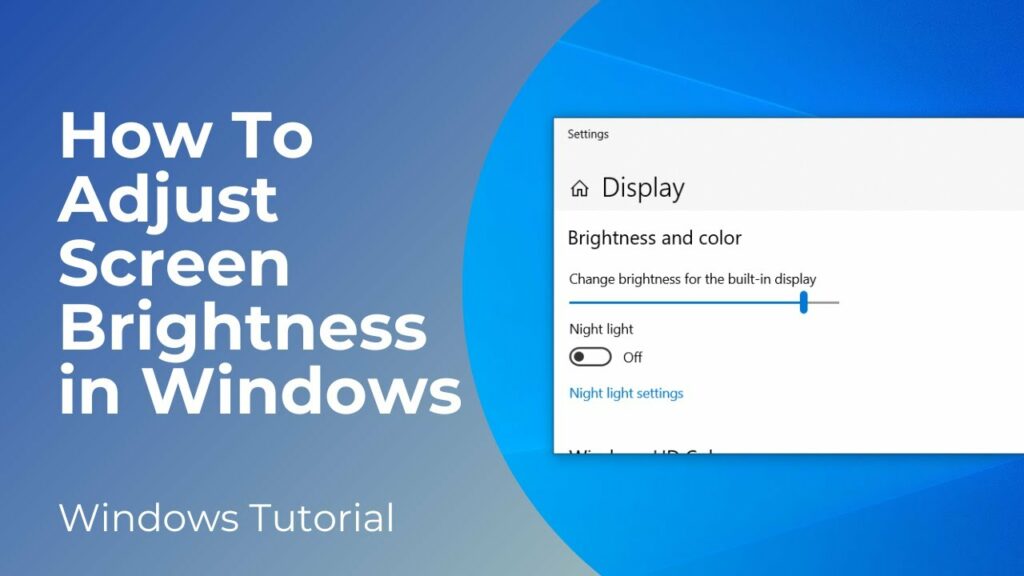Illuminating the Path: A Comprehensive Guide on How to Change Screen Brightness in Windows 10

Introduction:
Windows 10, Microsoft’s versatile operating system, empowers users with an array of customization options, including the ability to control screen brightness. Whether you’re adjusting brightness for comfort, conserving battery life on a laptop, or fine-tuning your display for different environments, this guide will serve as an exhaustive resource on how to change screen brightness in Windows 10. From built-in features to advanced settings, we’ll explore the myriad ways you can illuminate or dim your digital world according to your preferences.
Built-in Methods for Changing Screen Brightness:
Method 1: Using the Settings App
- Access the Settings App:
- Open the “Start” menu and click on the “Settings” gear icon (alternatively, press
Win + I).
- Open the “Start” menu and click on the “Settings” gear icon (alternatively, press
- Navigate to System Settings:
- In the Settings window, select “System.”
- Choose Display Settings:
- Click on “Display” in the left-hand menu.
- Adjust Brightness:
- Under the “Change brightness” section, use the slider to adjust the screen brightness according to your preference.
Method 2: Using the Action Center
- Open Action Center:
- Click on the Action Center icon located in the system tray or press
Win + A.
- Click on the Action Center icon located in the system tray or press
- Adjust Brightness Slider:
- In the Action Center, locate the brightness slider. Slide it left or right to decrease or increase brightness, respectively.
Changing Screen Brightness on Laptops:
Method 3: Using Function Keys
- Locate Function Keys:
- On many laptops, there are dedicated function keys (e.g., F2 and F3) for adjusting brightness.
- Use Function Key Combinations:
- Typically, you can adjust brightness by holding down the “Fn” key and pressing the corresponding function key with a brightness icon.
Method 4: Power Options Settings
- Access Power Options:
- Right-click on the battery icon in the system tray and select “Power Options.”
- Adjust Plan Settings:
- Click on “Change plan settings” for your selected power plan.
- Configure Brightness Settings:
- Click on “Change advanced power settings” and navigate to the “Display” section. Adjust the brightness settings accordingly.
Advanced Settings for Changing Screen Brightness:
Method 5: Graphics Driver Settings (Intel Graphics Control Panel)
- Access Graphics Control Panel:
- Right-click on the desktop and select “Graphics Options” or “Graphics Properties.”
- Navigate to Display Settings:
- In the Graphics Control Panel, go to “Power” or “Power Options” and adjust the display brightness.
Method 6: Registry Editor
- Access Registry Editor:
- Press
Win + R, type “regedit,” and press Enter to open the Registry Editor.
- Press
- Navigate to Display Key:
- Go to “HKEY_LOCAL_MACHINE\SOFTWARE\Intel\Display\igfxcui\profiles\media\Brighten_Level0” or a similar path based on your graphics driver.
- Adjust Brightness Values:
- Modify the “ProcAmpBrightness” value to adjust brightness. Caution: Editing the registry can have system-wide effects, so proceed with care.
Tips for an Optimal Screen Brightness Experience:
- Adapt Brightness to Environment:
- Adjust brightness based on ambient light conditions to reduce eye strain.
- Battery Conservation:
- Lower brightness when on battery to conserve power on laptops.
- Use Night Light:
- Enable the Night Light feature in Windows 10 to reduce blue light emission for a more comfortable viewing experience in the evening.
- Calibrate Display:
- Perform display calibration to ensure accurate color representation.
- Update Graphics Drivers:
- Ensure your graphics drivers are up-to-date to access the latest features and optimizations.
- Explore Third-Party Tools:
- Consider third-party tools for more advanced brightness control and additional features.
Conclusion:
Windows 10 offers a plethora of methods for users to control and customize their screen brightness, catering to different preferences and scenarios. Whether you prefer the simplicity of the Settings app, the convenience of function keys on laptops, or the advanced settings accessible through graphics control panels, this guide has illuminated the path to screen brightness customization. Experiment with these methods, find the perfect brightness level for your needs, and enhance your Windows 10 experience by taking control of the luminosity that surrounds your digital world.




